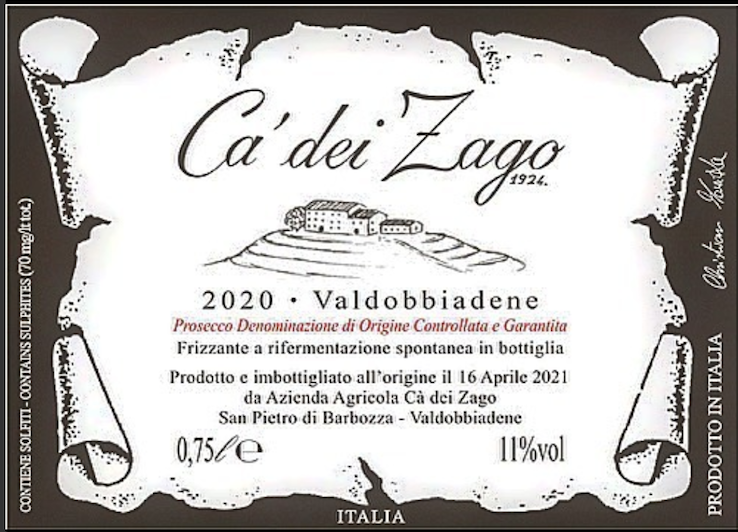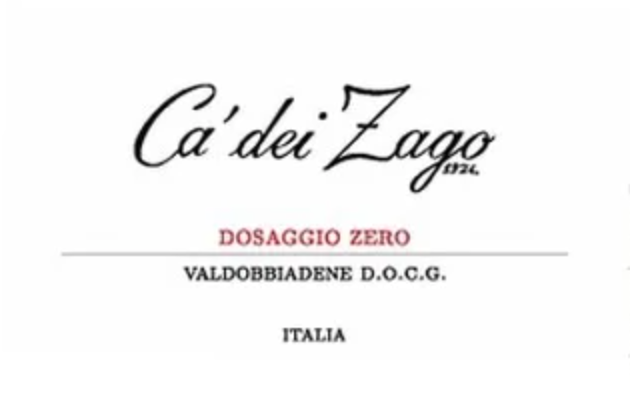Poetry in Prosecco
Christian Zago, accompanied by Marika, represents the 5th generation of growers at Ca’ dei Zago, a family farm in the heart of Valdobbiadene. The most important part of this family legacy is the vineyards—now totalling around 6.5 hectares—and the hands-on, hands-off way the Zagos treat them. Since the origin as a mixed farm in 1924, the family have never used chemical fertilisers, an approach that Christian has been taking to the next level, being an eloquent proponent and practitioner of biodynamics. He is a strong believer that you can’t replace in the winery what nature didn’t give you in the vineyard.
Influenced by the writings of Nicholas Joly and having worked at a biodynamic estate in New Zealand, Christian returned to the farm in 2010 and began to restore the equilibrium of the vineyard and promote biodiversity in-and-around the co-planted vines. One of the first things he did was to start their own compost using materials present in the vineyards. The vines themselves come mostly from old rootstock and Christian’s own massale selection from a nursery next to their house.
The terraced vineyards in Valdobbiadene are steep, precluding almost all use of machinery. The work is exacting, both in the vines for the Col Fondo, and even more so for the Metodo Classico, a more detailed wine from Zago, one showcasing the unique terroir of Bastia, which hails from a 2-hectare plot planted with old mixed vines right next to the famous Cartizze cru.
The winery is a simple place and free of gizmos and oenological toys. This is all about bringing the best of farming practice to the bottle.
Christian uses concrete vats from the 70s alongside more modern oval-shaped vessels from the same material. For him, concrete works well for fermentation because it confers stable temperatures, as well as allowing the wine to breathe. The whole cellar is located underground, so the grapes and juice can be moved by gravity. The thin-skinned Glera (the main Prosecco variety) berries have thin skins, thus requiring delicate handling, namely manual harvesting into small crates, sorting, hand-destemming and delicate pressing. Another essential part of the process is a 2-day maceration that endows the young wine with all the matter it requires for a good, long life as well as the tannins that help to naturally clarify the wine.

As for the wines, the Col Fondo is from vines that are up to 90 years growing at 250 metres asl on soils comprising clay and sand with flints. The varieties are intriguing, with the Glera from very old clones supplemented by small amounts of local, but relatively unknown, Verdiso, Perera, and Bianchetta from massale selection. This unusual grape palette gives something truly distinctive to the final wine.
The grapes are harvested by hand in small crates and are then selected and delicately destemmed on a sorting table. After being crushed, the must is transferred using gravity to cement tanks. Maceration with skins is carried out for 2 days with occasional punching down. Alcoholic and malolactic fermentation both occur spontaneously. The wine rests over the winter, racked only when necessary, during a waning third-quarter moon. Clarification, tartaric and protein stabilisation all occur naturally – no fining or filtration here.
In spring, with the first waxing first-quarter moon of March and April, the wines are bottled, also using gravity. At this stage the alcohol is around 9% and this is some sweetness in the must. The continuing fermentation occurs spontaneously in the bottle, generating gentle fizz and sediment in the bottom (or fondo) of the bottle. The bottles spend a further three months stored horizontally to ensure that the wine gains further harmony through this contact with the cork and oxygen. No disgorgement is done – this is, after all, col fondo! A little bit of sulphur is used after malo.
This is everything you hope for from Col Fondo – with that bit extra. The wine is light and refreshing, with pleasant notes of citrus, honeysuckle and wet stone. There is lively acidity, purity, precision and fine long-lasting bubbles. You can drink it the local way, decanted off the lees and then a final turbo-charged glass of turbidity, or half-and-half or shaken up to distribute the sediment through the wine, an action that imbues with a richer, creamier texture. A very refined mousse, subtle orchard fruit flavours, elegant minerality – what a classy Prosecco.

The Metodo Classico is from the aforementioned parcel of 50 + year old terraced vines situated further up the slope (300-400 m above sea level) on clay-limestone soils. The Glera (90%), Verdiso (5%), Perera and Bianchetta (5%) hail from a single-vineyard located in Bastia di Mondeserto, Frazione di Saccol in Valdobbiadene. The extra altitude and soil profile combine to give this wine its super-precise personality.
The vinification is the same as for the Col Fondo until bottling when a liqueur de tirage is added to prompt the second fermentation. The wine is stored for 14-18 months in riddling racks with Marika Zago regularly turning them all by hand. The wine is then disgorged and topped-up, using zero dosage.
This is a light-bodied sparkling wine, but with beautiful tension, lively acidity and pleasing chalky minerality. Although the traditional method of secondary fermentation in bottle is not typical for the Prosecco region, Christian liked the results from his initial experiment with this style about ten years ago and has since gone with it. As one might expect, the wine is more delicate and subtler than col fondo, with a truly lovely racy quality and finesse that captures the terroir perfectly.
2020 Valdobbiadene Frizzante ‘Col Fondo’
2019 Metodo Classico
*
Interested in finding more about Ca’ dei Zago Prosecco? Contact us directly:
shop@lescaves.co.uk | sales@lescaves.co.uk | 01483 538820

